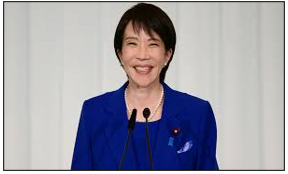Japan’s First Woman Prime Minister
Context: Recently, Japan’s ruling Liberal Democratic Party (LDP) elected Sanae Takaichi as its new leader, positioning her to become Japan’s first female Prime Minister.
More on the News

- The leadership election was held on October 4, 2025, at the LDP headquarters in Tokyo.
- Sanae Takaichi defeated centrist rival Shinjiro Koizumi in a runoff vote.
- She is expected to be formally elected as Prime Minister in mid-October when the lower house of Japan’s parliament, the Diet, holds its leadership vote.
- Takaichi will replace Shigeru Ishiba, who resigned after a series of election defeats led to the LDP losing its majority in both parliamentary houses.
- Her victory marks a major political shift within the LDP towards the conservative and nationalist right wing.
About Sanae Takaichi
- Sanae Takaichi is a veteran Japanese politician known for her conservative and nationalist stance.
- She has held several key cabinet positions, including Minister for Economic Security, Minister for Internal Affairs and Communications, and Minister for Gender Equality.
- Takaichi often cites Margaret Thatcher as her political inspiration and has pledged to revive “Abenomics”, the late Shinzo Abe’s economic policy framework that combined fiscal stimulus, monetary easing, and structural reforms to boost growth.
Centre–State Tussle over Damodar Valley Floods in West Bengal
Context: The West Bengal Chief Minister has accused the Damodar Valley Corporation (DVC) of releasing excessive dam water that caused floods in West Bengal during the festive season.
More on the News
- The Chief Minister alleged that the DVC “wilfully” released more than 1,50,000 cusecs of water from the Maithon and Panchet dams, causing “man-made floods” in several districts of West Bengal.
- The statement came ahead of the Durga Puja festival, as floods affected regions in both North and South Bengal.
- The DVC denied the charges, stating that it had released only 70,000 cusecs of water, not 1,50,000 cusecs, and had informed all stakeholders beforehand.
Damodar Valley Corporation (DVC)
- Established on 7 July 1948 under the Damodar Valley Corporation Act, 1948, and was India’s first multipurpose river valley project, created jointly by the Central Government and the Governments of West Bengal and Bihar (now Jharkhand).
- DVC aims to control floods, provide irrigation, generate power, and promote regional development in the Damodar River basin.
- The Damodar Valley Reservoir Regulation Committee (DVRRC) guides the DVC in managing water release based on rainfall and storage conditions.
Meghalaya Film Tourism Policy 2025
Context: The Meghalaya government has introduced the Film and Music Promotion Policy 2025 to position the State as a preferred destination for film shoots, web series, and cultural productions.
More on the News

- The policy offers financial incentives and logistical support to filmmakers and production houses.
- Films shooting 75% of their content in Meghalaya are eligible for up to ₹1 crore in financial assistance.
- An additional ₹50 lakh is provided if productions engage local artists, musicians, and technical talent.
- The policy was introduced in July 2025, is receiving a very positive response from players in the film industry.
- The state is also focusing on building a vibrant concert economy to enhance its tourism and cultural appeal.
- In the previous year, the state government spent ₹23.50 crore on promoting concerts, which generated ₹133.42 crore in revenue, showing a fivefold return on investment.
Subsidy Under the Scheme

UPI Incentive for Non-FASTag Users
Context: To promote digital payments and reduce cash transactions at toll plazas on National Highways, the Government of India has amended the National Highways Fee (Determination of Rates and Collection) Rules, 2008.
More on the News

- Cash Payment Penalty: Vehicles entering a fee plaza without a valid, functional FASTag will be charged twice the applicable user fee if payment is made in cash.
- UPI Payment Incentive: Users paying via the Unified Payment Interface (UPI) will be charged 25 times the applicable user fee.
- For example, if a vehicle needs to pay a user fee of ₹100 through a valid FASTag, the fee will be ₹200 if paid in cash and ₹125 if paid via UPI.
- Effective Date: The new rules will come into effect from November 15, 2025.
- Objectives & Key Purpose of the Reform:
- Strengthen the fee collection process and reduce cash handling costs and leakages, leading to operational savings for the authority.
- Promote digital payments, reduce dependence on cash, and encourage wider adoption of UPI and FASTag usage.
- Enhance transparency, ease of commuting, and improve user experience on national highways.
- Currently, around 98% of toll payments are made through FASTag, while 2% are still paid in cash, indicating scope for further digital inclusion.
Dark Stars
Context: Recently, Astronomers using the James Webb Space Telescope (JWST) may have identified a new type of star powered by dark matter annihilation instead of nuclear fusion.
More on the News
- The researchers led by Cosmin Ilie (Colgate University) and Katherine Freese (University of Texas at Austin) analyzed JSWT data.
- They identified four celestial objects (JADES-GS-z11-0, z13-0, z14-0, z14-1) consistent with the theoretical predictions for Dark Stars.
- These findings were published in the Proceedings of the National Academy of Sciences and could reshape theories of how the first luminous bodies formed after the Big Bang.
Dark Stars
- These are hypothetical giant, puffy, luminous stars theorised to have existed in the early universe, powered by the annihilation of dark matter rather than nuclear fusion.
- The concept of Dark Stars suggests that, in the early universe, dense clouds of hydrogen and helium within dark matter halos were heated by dark matter annihilation, preventing collapse into conventional stars.
- Such stars could remain cool (<10,000 K) yet extremely massive, up to a million times the Sun’s mass, shining billions of times brighter than normal stars.
- Observations, including tentative helium absorption features, provide the first potential evidence for this class of stars.
- These objects could explain both the unexpectedly bright early galaxies observed by JWST and the formation of supermassive black hole seeds.

